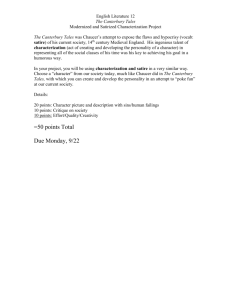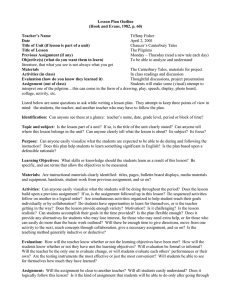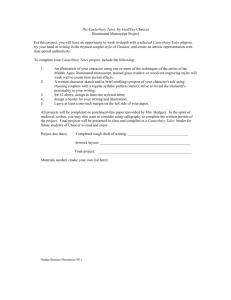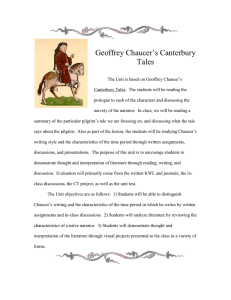Chaucer Lecture
advertisement
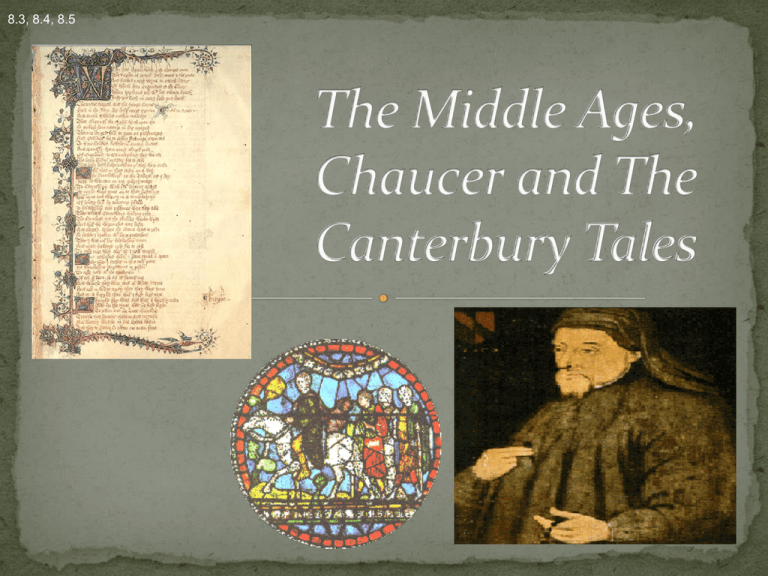
8.3, 8.4, 8.5 Be Thankful You Missed It •French did not become either the official or unofficial language of England. •William was not combining the lands of Normandy and England, and had no wish to replace language or culture. •Latin and English were used for most documents and formal proclamations by William, and the English legal system was renewed, not replaced. •Nevertheless, the upper class was almost completely taken over by (French speaking) Normans, and although the system was English, many of the legal proceedings and documents were in French. • law of the land • upper nobility class maintained control over the lower classes • rigid structure of government consisted of kings, nobles (barons), and the peasants (serfs) • leaders of the church and neighboring nobles held sway • king needed a way to maintain control over his lands, even if indirectly • barons were given a large portion of the king's land, known as fiefs or manors. In turn, they had to pay "homage and fealty" to the king • gave their support to the king at all times, governing the land that was given them, and being ready to provide troops and fight for the king when the need arose More Pictures • Murdered in 1170 (Assassinated by followers of the King Henry in Canterbury Cathedral) • Was canonized as both Saint and martyr following his murder • The Shrine of Saint Thomas of Beckett became a popular destination for religious pilgrimages during the Middle Ages • 1348 – Black Plague reached England and wiped out 1/3 of the population (2.25 million to 3.75 million) • The sudden collapse of the population sent prices skyrocketing by increasing the price of labor while decreasing the price of land • The overall effect of the Plague was to hasten the collapse of feudalism by creating intense competition for labor and tenants Illustration of the Black Death from the Toggenburg Bible (1411) His Life & Times Son of London vintner (winemaker) Served in the royal household (page to 2nd son of Edward III) and later held a series of administrative posts under Edward and Richard II. Visited France and Italy on behalf of the crown during the 1360's and 1370‘s. Chaucer's career illustrates the economic, political, and social ferment of late 14th century England (landed wealth versus moneyed wealth). Well-travelled on diplomatic missions for the king Read English, Latin, Italian, and French Recall some things you read from our textbook An Overview Begun: 1386 Planned: 120 tales Completed: 22 tales and 2 fragments Pilgrimage was a “framing device” for tales; tales also have “thematic unity”. The pilgrims share stories to pass the time; these stories described the very different points-of-view and beliefs and practices of the people of Chaucer’s age. Those Who Work (Peasants & Middle Class) Merchants, Laborers, Farmers, Government officials, etc. Those Who Pray (Clergy) Priests, Monks, Nuns, Friars, Pardoners Those Who Fight (Nobility) Knights, Squires, Mercenaries, Princes, Dukes, etc. Pilgrimages began as exercises in penance (attempt to earn forgiveness) Roads were poorly maintained. Thieves hid in wait for lone travelers, so most people traveled as “pilgrims” in a large group. Later on, travel improved, but getting to faroff spots (e.g. Jerusalem) was never easy or safe. “Professional” pilgrims returned with relics, badges, pilgrim symbols, tall tales (some of these were falsified). Frame Story: a story that holds together several other stories; usually, characters in the frame story tell stories of their own. e.g. each of the characters in The Canterbury Tales tells their own story, which has a new, unique cast of characters. The Canterbury Tales is the story of a group of pilgrims who tell stories as they travel to Canterbury; each pilgrim’s story stands alone as its own story, but fits within the overall story of the journey. Indirect Characterization occurs when an author tells what a character does, says, or looks like, or describes how other characters react to him or her. The reader must use their judgment to decide what the character is like. What can you infer about this character: Bill straightened his starched suit and slicked back his hair; he nudged his toothbrush to line up parallel with his toothpaste before he looked at himself in the mirror, then smiled with satisfaction. Chaucer uses these types of indirect characterization (and others): “This yeoman wore a coat and hood of green, And peacock-feathered arrows, bright and keen” (Appearance) Her greatest oath was only “By St. Loy!” (Speech) “And gladly would he learn, and gladly teach.” (Attitude/Behavior/Feelings) Direct characterization occurs when the author states a character’s traits—virtuous, vain, clever, etc. e.g. Bill was vain and self-centered. Chaucer also uses direct characterization, especially on his minor characters: There was a Friar, a wanton one and merry, A Limiter, a very festive fellow. • irony: incongruity between what might be expected and what actually occurs. • coincidence is not irony, though the two are similar. • verbal irony: The contrast between what is said and what is actually meant. • the surface meaning and the underlying meaning of what is said is not the same. • Chaucer provides some details that contradict what the characters think of themselves. This is a form of satire: • witty language convey insult/scorn • ridicules its subject (for example, individuals, organizations, or states) often as an intended means of provoking or preventing change 1. Accurate depiction of life in the middle ages (class levels, interactions between the classes) 2. First story about lower classes (mix of classes) 3. Satire & humor for social / political / religious commentary. 4. “The Canterbury Tales” point out problems within society. social rank, moral & spiritual condition Include many of the following Physiognomy – physical features (esp. facial) Clothes Job Hobbies Food Choice Humor Their Words Some tales are serious, others are comical. Each is an accurate description of a set of traits, beliefs, and faults. Chaucer criticized the malpractice of the clergy, and poked fun at those from the 3 estates. (nobility, clergy, commoner) Many of the tales shared similar themes; some tales are told in response to a previous tale (e.g. a story about the joy of immorality is followed by a story about the punishment for sinners) The Prologue The Prologue to The Canterbury Tales Reading Skills: Analyzing Style: Key Details •As you read the Prologue, pay close attention to any details that help give you an immediate impression of a character. Assignment: • Handout • Pay attention to direct and indirect characterization for the characters Narrator is Chaucer, but don’t confuse “pilgrim Chaucer” with “author Chaucer” Narrator is acting as a reporter of what others say, not adding/removing. Pretends to be unaware of irony or satire. The Wife of Bath is one of three women on the trip. “She was a worthy woman all her life”, the narrator says, then mentions her 5 husbands. This is an example of ______. satire She is a business woman with a strong sense of self-importance, her elaborate dress is a sign of her character as well as her wealth. note that she is probably in her forties and is married to a man in his twenties The Summoner and the Pardoner are the most unlikeable figures; one administers the church courts, the other sells pardons (indulgences). The Pardoner is a church official who sells fake relics What impression of him do you get from this knowledge? The Summoner is suffering from some kind of skin disease. What might this tell us about him? The Knight & the Squire especially their dress and their resume The Monk well-fed and jolly, but something about him is unappealing The Yeoman the peacock-feathered arrows The Guildsmen their opinion of their own worth their clothing & accessories The Prioress (Nun) her physical description, education, manners The Plowman qualities the narrator seems to admire The Parson how he is different from the other clergy
